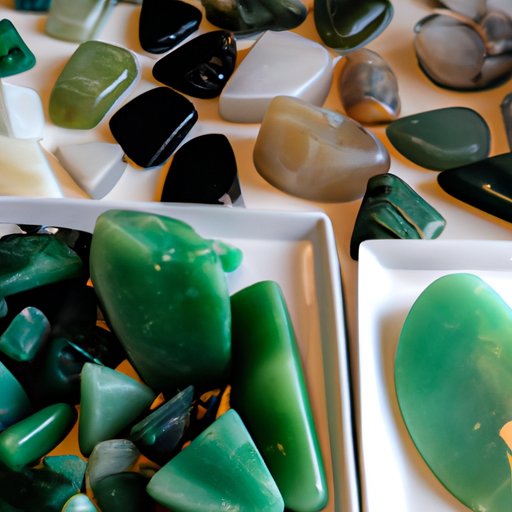Introduction
Jade has been known to humans for thousands of years and has always been regarded as a highly valuable substance. From its use as a significant cultural symbol to its healing properties, there are many reasons why jade is such an important substance. One question that many people may have about jade is whether or not it is a mineral. This article will explore the geological, chemical, and cultural significance of jade and answer the question, ‘is jade a mineral?’
Is Jade a Mineral?
Before answering the question, we must first understand what minerals are. Simply put, minerals are naturally occurring, inorganic substances that have a crystalline structure and a defined chemical composition. By this definition, jade can be classified as a mineral.
Jade is a general term that refers to two different types of minerals, namely jadeite and nephrite. Jadeite is a sodium aluminum silicate, while nephrite is a calcium magnesium iron silicate. Both minerals are considered jade and meet the criteria for being called minerals.
Unveiling the Mysteries of Jade: An In-Depth Analysis of Its Geological and Chemical Makeup
Jade is a metamorphic rock that is formed under high pressure and low temperatures. The process usually takes place when magma or molten rock comes into contact with pre-existing rocks deep within the Earth’s crust. This process forms jade in a rock form known as serpentine.
Jade’s chemical makeup can vary depending on its type. Jadeite jade has a chemical composition of sodium aluminum silicate, while nephrite jade’s composition is a complex calcium magnesium iron silicate. Different types of jade have varying colors ranging from white to green, blue, black, and lavender.
Jade is identified and evaluated by its color, texture, and translucency, but the most accurate way to test its quality is by measuring its density, hardness, and refractive index. As a result, many gem labs use these tests to certify the quality of jade.
Jade Through the Ages: A History of Its Significance, Properties and Uses
Jade has been highly valued in various cultures around the world throughout history. In ancient China, jade was believed to represent virtue, morality, and purity. It was also used for making ceremonial objects, musical instruments, and even weapons.
Jade’s unique properties also made it highly sought after by ancient Mesoamerican cultures, such as the Maya and the Aztecs, who believed it had significant spiritual properties. During the Renaissance period, jade was used in European jewelry as a symbol of wealth and social status.
Today, jade is commonly used for jewelry and decorative purposes, as well as in various carvings and sculptures. Jade is also believed to have healing properties and is used in traditional Chinese medicine to treat a range of ailments.
Jade Mining and Production: How this Mineral is Extracted and Processed
Jade is mainly mined in China, Russia, Myanmar, Canada, and the United States. Mining for jade is a labor-intensive process that involves using heavy machinery to dig deep underground and extract the rocks containing jade.
Once extracted, the rock is cut and processed to remove the jade. This is done using large saws that can cut through the rock with precision. Once the jade has been separated from the rock, it is further processed and cut using various tools to create different shapes and sizes.
The Remarkable Healing Properties of Jade: A Scientific Investigation
Jade has long been believed to have healing properties. In traditional Chinese medicine, jade is believed to have various health benefits, including promoting longevity, enhancing the immune system, and improving overall health and well-being.
While there is little scientific evidence to support these beliefs, recent studies have shown that jade may have some beneficial properties. For example, a study published in the Journal of Materials Science found that jade has high infrared radiation absorption, which can help improve circulation and relieve pain.
Today, jade is used in various forms of alternative medicine, such as crystal healing, which is said to promote healing and relaxation.
Jade and Its Place in the World Gemstone Market: A Comparative Analysis with Other Precious Stones
Jade is considered a valuable commodity and is highly sought after in the gemstone market. The rarity and quality of jade determine its value.
Compared to other precious stones, such as diamonds and sapphires, jade is rarer and more difficult to find. As a result, high-quality jade can be more valuable than diamonds and other gemstones.
Jade is traded and sold in various ways, including at auctions, gem shows, and online marketplaces.
Conclusion
In conclusion, jade is a mineral that has significant geological, chemical, and cultural significance. Its unique properties and long-standing beliefs that jade has healing powers make it a valued commodity. Jade is mined and processed to create various decorative and medicinal objects. In addition to its historical significance as a symbol of wealth and social status, jade has been used in spiritual practices and in modern times is considered an alternative medicine. Anyone wondering ‘is jade a mineral?’ can rest assured that it is a valuable and highly sought after mineral.
(Note: Is this article not meeting your expectations? Do you have knowledge or insights to share? Unlock new opportunities and expand your reach by joining our authors team. Click Registration to join us and share your expertise with our readers.)
